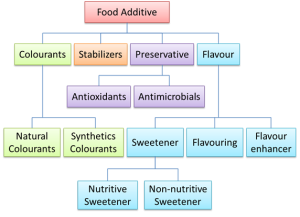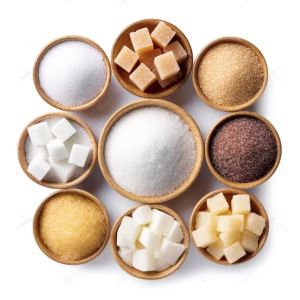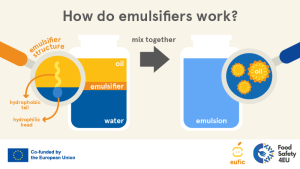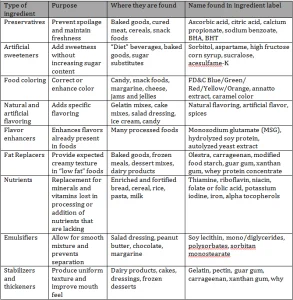27 Food Additives and Ultra Processed Foods: Functions, Impacts, and Future Implications
Mytika Mayberry
Introduction
Food processing has undergone a dramatic transformation over the past several decades. This shift has been fueled by rapid technological advancements that emphasize convenience, cost-efficiency, and scalability. As societies urbanize and lifestyles become increasingly fast-paced, the demand for shelf-stable, ready-to-eat, and easily accessible food products has risen substantially. Central to this transformation is the growing reliance on food additives, which are used to enhance flavor, preserve freshness, improve appearance, and stabilize food textures.
Food additives have enabled the large-scale production and distribution of ultra-processed foods, industrial formulations made primarily from substances extracted or derived from foods, with little to no whole food content. These ultra-processed foods (UPFs) dominate modern dietary landscapes, particularly in high-income nations but increasingly in middle- and low-income regions as well. They are found in everything from colorful breakfast cereals and fizzy soft drinks to frozen meals and snack bars.
While food additives play key roles in ensuring food safety and appeal, increasing scientific scrutiny has revealed possible health risks associated with chronic exposure. As UPFs become dietary staples, especially among younger populations, questions about the long-term health effects of additive consumption have sparked global concern. This chapter explores the classification, roles, health implications, regulatory frameworks, and future direction of food additive use within the context of ultra-processed foods. It also considers consumer trends and innovations that may shape the next generation of processed foods.
Defining Food Additives and Ultra-Processed Foods
According to the World Health Organization (WHO), food additives are substances not normally consumed by themselves as food or used as typical ingredients, but rather added to food products to perform specific technological functions such as preservation, coloring, sweetening, or texturizing. These substances are not consumed as foods themselves nor used in traditional home cooking. Similarly, the U.S. Food and Drug Administration (FDA) defines additives as substances that directly or indirectly influence the characteristics of food, including taste, safety, appearance, and shelf life (FDA, 2022).
Ultra-processed foods are distinct from minimally or moderately processed foods. Based on the NOVA classification system developed by Monteiro et al. (2019), UPFs are characterized by their industrial nature and the presence of ingredients rarely used in home kitchens, such as hydrogenated oils, maltodextrins, synthetic sweeteners, artificial colorants, and flavor enhancers. These foods are typically low in fiber, protein, and essential micronutrients but high in sugars, unhealthy fats, sodium, and additives, and this is because they undergo extensive processing and often contain little to no whole food ingredients.
Examples of UPFs include packaged snacks such as chips and cookies, soft drinks and flavored beverages, sweetened breakfast cereals, reconstituted meat products like hot dogs and chicken nuggets, and instant noodles or ready-to-eat frozen meals. These products are engineered for palatability, convenience, and long shelf life, often masking their poor nutritional profiles with the help of food additives. The industrial design of these foods often prioritizes mouthfeel, appearance, and consistency, leveraging chemical additives to replicate the sensory experiences of home-cooked meals without requiring fresh ingredients.
Types of Food Additives and Their Functional Roles
Food additives are diverse and multifunctional. They are generally classified by their purpose in food processing and can be either natural, derived from plants or animals, or synthetic, created through chemical synthesis.


Preservatives are perhaps the most historically significant additives. They inhibit spoilage caused by microbes or oxidation, thus extending shelf life and reducing food waste. Common preservatives include antioxidants such as butylated hydroxytoluene (BHT), which delay rancidity in oils and fats, and antimicrobials like sodium benzoate or nitrates, which prevent bacterial, yeast, or mold growth. Sodium nitrate and sodium nitrite, frequently used in cured meats, have been scrutinized due to their potential to form nitrosamines, carcinogenic compounds linked to colorectal and stomach cancers (Nabavi et al., 2020). However, their continued use is justified by their ability to significantly reduce botulism risk in processed meats.

Colorants restore or enhance visual appeal lost during processing. While natural colorants such as beet juice or turmeric extract are generally considered safe, they often degrade quickly or impart unintended flavors. Synthetic dyes, such as Red Dye 40 and Yellow 5, offer vibrancy and stability but have raised health concerns. Studies link synthetic dyes to DNA damage, hyperactivity and attention issues in children, and inflammatory gut responses (Bancil et al., 2024). Titanium dioxide, used for its whitening effect, has been banned in the European Union due to genotoxicity concerns, despite still being approved in the United States. It is still commonly found in items like chewing gum, candy coatings, and even toothpaste.
Flavor enhancers intensify taste without contributing specific flavors themselves. The most well-known is monosodium glutamate (MSG), widely used in savory snacks, canned soups, frozen meals, and instant noodles. Although generally recognized as safe (GRAS) by the FDA, MSG has been linked anecdotally to symptoms such as headaches, nausea, and flushing, a phenomenon sometimes referred to as “Chinese Restaurant Syndrome.” Emerging evidence also points to potential neurotoxicity with excessive consumption, although conclusive data remains limited (Food Additives and Human Health, 2021). MSG’s ability to enhance the umami taste can mask the absence of more nutrient-rich ingredients, allowing food manufacturers to use less meat, cheese, or vegetables in their formulations.

Artificial sweeteners and high-intensity sweeteners are ubiquitous in UPFs and are designed to replicate the sweetness of sugar without its caloric content. High-fructose corn syrup (HFCS), aspartame, sucralose, and saccharin are among the most common. HFCS has been implicated in the obesity epidemic, insulin resistance, and non-alcoholic fatty liver disease. Aspartame, despite widespread use, remains controversial due to potential associations with mood disturbances, headaches, and neurological symptoms, particularly in sensitive individuals (Quitral et al., 2019). Sucralose and saccharin have also been investigated for potential effects on gut bacteria, insulin sensitivity, and long-term metabolic health.

Emulsifiers, thickeners, and stabilizers are used to maintain uniform texture and prevent ingredient separation. Common examples include lecithin as an emulsifier, xanthan gum and guar gum as thickeners, and carrageenan as a stabilizer. These ingredients are found in a wide range of products, from creamy salad dressings to dairy alternatives and ice creams. While generally effective and stable, some of these additives are linked to gut microbiota disruption, increased intestinal permeability, and chronic inflammation (Chassaing et al., 2022). Potassium bromate, used to improve dough elasticity in bread-making, is banned in many countries due to its potential carcinogenic effects but remains permitted in the U.S.
Acidulants and pH regulators alter food acidity to enhance flavor or inhibit microbial growth. Examples include citric acid, lactic acid, and phosphoric acid, the latter of which is found in cola beverages. While these compounds are essential in products like pickles, sauces, and soft drinks, excessive consumption may erode dental enamel and contribute to bone demineralization. Long-term intake of phosphoric acid, for example, has been associated with reduced bone mineral density in some epidemiological studies, especially among adolescents with high soda consumption.
To compensate for nutrient losses during processing, manufacturers often fortify foods with vitamins and minerals, such as vitamin D in dairy, iron in breakfast cereals, or folic acid in flour. These are called nutrient additives, while fortification can be beneficial, especially in populations with limited access to whole foods, it does not compensate for the high sugar, fat, and additive content typical of UPFs. Some nutritionists argue that fortification may provide a false sense of healthfulness, encouraging consumption of otherwise nutrient-poor products.
Health Implications of Additive-Laden Diets
An additive-laden diet refers to a pattern of eating that includes a high intake of foods containing artificial or synthetic additives—such as preservatives, colorants, flavor enhancers, sweeteners, emulsifiers, and stabilizers—commonly found in ultra-processed foods. This type of diet often emphasizes convenience and shelf stability over nutritional quality. [AI] Emerging evidence links UPF consumption with several adverse health outcomes, including obesity, anxiety, depression, cardiovascular disease, and cancer (Monteiro et al., 2019). Scientific research has confirmed this and have linked additives and UPFs to a variety of health concerns. Studies suggest that MSG may contribute to neurotoxicity, emulsifiers can lead to gut inflammation, and synthetic colorants are associated with behavioral issues and microbiome disruption (Bancil et al., 2024). Titanium dioxide and Red Dye 40 have been shown to penetrate cellular structures and interfere with DNA repair, further raising carcinogenic concerns (Nabavi et al., 2020).
Additionally, case studies demonstrate elevated risks of colorectal cancer from consumption of processed meats high in nitrates. Artificial sweeteners have also been implicated in metabolic disorders, especially among children and adolescents (WHO, n.d.). While individual additives are often deemed safe within specific limits, their cumulative and synergistic effects, and especially when consumed daily in multiple food products will raise valid public health concerns.
Metabolic Disorders:
A high intake of UPFs is associated with increased risks of obesity, insulin resistance, and type 2 diabetes. Artificial sweeteners, emulsifiers, and preservatives may interfere with glucose metabolism and appetite regulation. For instance, non-caloric sweeteners like sucralose and aspartame have been shown to alter gut microbiota in ways that impair insulin sensitivity (Suez et al., 2014). Additionally, emulsifiers such as carboxymethylcellulose and polysorbate 80 have been linked to inflammation of the intestinal lining, contributing to metabolic syndrome (Chassaing et al., 2015).
Cardiovascular Health:
Frequent consumption of UPFs correlates with hypertension, dyslipidemia, and cardiovascular disease. Additives like sodium phosphates increase the bioavailability (which is the proportion of a nutrient, drug, or other substance that enters the bloodstream and is available for use or storage in the body after it is consumed) of phosphorus, which may elevate cardiovascular risk by promoting vascular calcification. Moreover, high sodium levels from multiple additive sources contribute to excessive daily salt intake, a leading cause of high blood pressure.
Cognitive and Neurological Effects:
Emerging research explores the effects of food additives on brain health. Certain dyes, especially those banned in some countries but still allowed in others—have been linked to hyperactivity and attention difficulties in children. Although the mechanism remains unclear, it is hypothesized that synthetic dyes may interfere with neurotransmitter function or act as neurotoxins at high doses.
Cancer Risk:
Several additives raise red flags for carcinogenicity. As noted, sodium nitrite can convert into nitrosamines under high heat or acidic conditions, such as in the stomach. Potassium bromate, banned in the EU, Canada, and other nations, is still used in some baked goods in the U.S. despite its classification as a potential human carcinogen. The International Agency for Research on Cancer (IARC) has also evaluated additives like titanium dioxide, listing it as possibly carcinogenic when inhaled in nanoparticle form.
Gut Microbiome Disruption:
One of the most concerning impacts of food additives lies in their ability to alter the gut microbiota. Additives like emulsifiers and synthetic sweeteners can reduce bacterial diversity and promote the growth of pro-inflammatory strains, leading to gut dysbiosis. A healthy gut microbiome is crucial not only for digestion but also for immune regulation, mental health, and chronic disease prevention. Disrupting this ecosystem may have cascading effects on long-term health.
Regulation and Safety Assessments Nationally and Internationally
Food additives undergo extensive safety evaluations by national and international agencies. In the United States, the FDA maintains a list of substances designated as Generally Recognized as Safe (GRAS), based on scientific evidence or a long history of safe use. Additives not on this list must undergo premarket approval, which includes toxicological testing, exposure assessments, and risk-benefit analyses. However, critics argue that this system enables insufficiently tested additives to enter the market. Alongside this, concerns persist regarding cumulative exposure to multiple additives and their long-term effects on health.
By contrast, the European Food Safety Authority (EFSA) assesses additives for the EU, where regulations tend to be stricter and they mandate rigorous safety assessments for all food additives. For example, EFSA has banned titanium dioxide and potassium bromate, both still allowed in the U.S.. They are banned due to genotoxicity concerns and requires labels for additives like Tartrazine and Sunset Yellow that may affect children’s behavior. European policy also includes precautionary measures, such as warning labels on colorants and periodic re-evaluation of additive safety.
Internationally, the Joint FAO/WHO Expert Committee on Food Additives (JECFA) plays a central role in evaluating the safety of additives for global use. Organizations such as the Codex Alimentarius Commission set guidelines for additive usage. Although non-binding, these standards influence national policy, especially in low- and middle-income countries. There is also growing interest in harmonizing regulatory standards and encouraging data-sharing between countries to enhance food safety.
However, the regulatory system is not without criticism. One concern is the lack of long-term studies on cumulative and combined exposure. Most safety evaluations test individual additives in isolation, failing to account for additive-additive interactions. Another issue is regulatory lag; new research may uncover potential harm years after an additive has been approved, and re-evaluation can take considerable time.
Additionally, discrepancies between global regulations can create confusion for consumers. The same brand of candy may contain different ingredients depending on the country, leading some to question why certain additives are banned in Europe but permitted elsewhere. These inconsistencies highlight the need for harmonized global standards and more precautionary policies.
Scientific Debates and Controversies
A central debate in nutritional science is whether health risks arise from specific additives or from overall dietary patterns dominated by UPFs. Some researchers argue that individual additives such as Red Dye 40 and titanium dioxide pose direct harm, even in small quantities. Others suggest that the additive load in the context of nutrient-poor UPFs is the primary concern. A balanced view holds that both factors likely contribute, with additives exacerbating the health risks posed by poor-quality diets.
Future Directions of Consumer Trends and the Clean-Label Movement
There is ongoing debate about whether health risks are caused by individual additives or the broader dietary pattern involving high consumption of UPFs. While some additives may only be harmful in large quantities over time, others, such as titanium dioxide, pose risks even at low levels. In response to growing health concerns, consumers increasingly demand clean-label products with recognizable, minimally processed ingredients. Food manufacturers are reformulating products to exclude synthetic additives and emphasize transparency. This movement has gained more traction in Europe, where consumer advocacy is stronger and food labeling is more stringent. This has been forcing the food industry to explore alternative preservation methods, such as fermentation and high-pressure processing, to meet consumer demand for healthier options.

Natural Colorants and Preservatives:
Advancements in food science are enabling safer alternatives to synthetic additives. Plant-based pigments like spirulina, beetroot, turmeric, and paprika are replacing artificial dyes. Meanwhile, natural preservatives such as rosemary extract, vinegar, and fermented plant extracts are gaining popularity. While often more expensive or less stable, these alternatives are perceived as healthier and more acceptable by consumers. In addition, functional ingredients like probiotics and prebiotics are being used to maintain food quality while supporting gut health (EUFIC, 2023).
Fermentation and Bio-preservation:
Advancements in microbial fermentation have opened new avenues for natural preservation. Beneficial bacteria can produce antimicrobial compounds (e.g., bacteriocins) that extend shelf life without synthetic chemicals. Biopreservation aligns with the trend toward more sustainable and “whole food” ingredients.
Reformulation and Minimal Processing:
Some food companies are rethinking product design entirely, opting for fewer ingredients and minimal processing techniques. Innovations like high-pressure processing (HPP) and vacuum-steam technologies can reduce the need for additives by preserving food quality through physical means.
Smart Packaging:
Developments in food packaging may also reduce dependence on chemical preservatives. Smart packaging systems can monitor spoilage indicators or incorporate antimicrobial surfaces, extending shelf life while minimizing additives in the food itself.
Personalized Nutrition and AI-Driven Development:
As the field of nutrigenomics grows, food innovation is also becoming more personalized. Artificial intelligence is now being used to design customized food formulations based on individual health profiles. These systems can optimize nutrient content while minimizing additives, aligning health goals with consumer convenience.
Consumer Education and Public Health Advocacy
Public understanding of food additives remains limited. Many consumers struggle to interpret ingredient lists, especially when additives are listed by chemical names or numerical codes. Educational campaigns can help bridge this knowledge gap and empower individuals to make informed dietary choices.
Nutrition labels could also be improved by requiring clearer disclosures of additive types and functions. For instance, identifying whether an additive is a colorant, preservative, or emulsifier could help consumers avoid unwanted substances. Tools like the NOVA classification system and mobile apps that scan product barcodes for processing levels are also empowering informed shopping.
From a policy perspective, governments can encourage healthier food environments by taxing UPFs, subsidizing whole foods, and restricting the marketing of additive-heavy products to children. Schools, hospitals, and public institutions can serve as models by adopting procurement standards that limit harmful additives.
Ultimately, systemic change will require collaboration among scientists, policymakers, food manufacturers, and consumers. While additives have undeniably improved food safety and accessibility, and their overuse, especially in ultra-processed products, may be contributing to the very health crises they once helped mitigate.
Conclusion
Food additives have played a central role in the development and proliferation of ultra-processed foods. These substances offer undeniable functional benefits including convenience, extending shelf life, enhancing taste and appearance, and ensuring product consistency. However, their consistent use, particularly in nutrient-poor products, has prompted growing concern over potential health risks.
Regulatory bodies in the United States and Europe differ in their approaches, with the latter adopting a more precautionary stance. Emerging evidence linking certain additives to chronic disease underscores the need for stricter oversight, ongoing research, and industry innovation.
From metabolic dysfunction and gut microbiome disruption to neurological and carcinogenic concerns, the evidence suggests that the long-term consumption of additive-laden ultra-processed foods may be detrimental to health. While regulatory frameworks provide oversight, gaps remain in the assessment of cumulative and synergistic effects. The food industry’s shift toward cleaner formulations and the use of natural alternatives is a promising step forward.
Moving into the future, continued research, transparent regulation, consumer education, and innovation will be essential in balancing the benefits and risks of food additives. And as consumer awareness increases, the demand for transparency, clean labels, and natural alternatives will likely reshape food manufacturing practices. Balancing technological innovation with public health imperatives remains a pressing challenge for the global food industry. By fostering a more informed and health-conscious food system, championing grassroots movements and forcing lawmakers to informed decisions from sound research for the health of consumers. Society can better navigate the complexities of food technology while safeguarding public health.
Personal Statement:
So honestly, when I first started this project, I didn’t have many expectations for how much I would learn throughout the process. It has been enlightening just to see how deeply food additives and ultra-processed foods (UPFs) are embedded in our food system, not only in terms of what they’re used for but also the wide range of types and their purposes. While I already knew that additives could be found in almost everything, it was truly eye-opening to explore the long-term health effects of consuming synthetic food additives. As I reflected on these findings, I began to question the kind of eating habits I want to develop for myself, while also weighing the implications of striving for a holistic, health-centered lifestyle.
Through this research, this has continued to strengthen my nuanced understanding of the balancing act many people, and myself included, face between health and convenience. Currently, as a college student relying on SNAP benefits to buy food each month, I recognize that I am more fortunate than others in my position due to the fact that I’m able to afford fresh fruits and vegetables. However, even with access to these healthier options, I often lack the time and energy to prepare nutritious meals due to my full-time student status and working two jobs. This lived reality has helped me understand why so many people opt for ultra-processed convenience foods. In many cases, the choice between health and convenience isn’t a real choice at all, it’s actually a matter of circumstance and survival.
What became increasingly clear throughout this project is that the population most vulnerable to the impacts of ultra-processed foods isn’t only those in poverty, but also the middle class. Many middle-class individuals and families earn too much to qualify for government assistance like SNAP but not enough to live in full financial comfort. As a result, they often overwork; sometimes juggling multiple jobs, and this is just to make ends meet. This overextension of time and energy creates a gap where healthy cooking and mindful eating become less feasible. Convenience foods, which are cheaper upfront and require minimal preparation, start to look like the only viable option. It’s not about lack of awareness or unwillingness to eat better; it’s about survival in a system that doesn’t support the health of people caught in the economic middle.
The more I investigated, the more I saw how interconnected this issue is with broader societal problems, like wage stagnation, the rising cost of living, and lack of universal healthcare. These pressures make it harder for working-class and middle-income individuals to prioritize their health. The emotional toll of constantly sacrificing quality for affordability, and time for survival, is rarely addressed in public health conversations. We are quick to blame individuals for their food choices without acknowledging how systems have failed them.
From a researcher’s standpoint, this project challenged me to step outside of a purely academic perspective and look at food systems through ethical, social, and structural lenses. I had to question not only the safety of additives themselves but also the systems that normalize their widespread use. It made me think critically about how corporations, regulatory loopholes, and socioeconomic inequalities intersect to shape public health outcomes. For example, I found that the GRAS regulation, which is intended for additives that are “generally recognized as safe”—is often exploited by companies to bypass more rigorous safety testing. This loophole allows additives to enter the market without sufficient oversight. Similar tactics are used in other parts of the industry, where profits are prioritized over public safety. And through all of this, I found myself asking why certain additives remain legal in the U.S. despite being banned in Europe, and what that says about our regulatory priorities. I also considered how industry lobbying influences which ingredients are deemed “safe,” and how consumer awareness, or lack thereof, plays a role in the ongoing consumption of harmful substances.
Additionally, this reflection forced me to reconsider some assumptions I had about personal responsibility and diet. I have always known the systemic barriers that affect those in poverty and how closely this links to diet. Things like time poverty, income limitations, and food marketing often make healthy eating inaccessible. This project showed me that studying food additives and their implications on an individual’s diet isn’t just about evaluating facts; it’s also about questioning the structures behind those facts and thinking through their broader implications for individuals and society as a whole. And for that, I am eternally grateful.
To improve our food systems locally and even globally, we need more than personal willpower or nutrition education—we need policy reform, corporate accountability, and grassroots advocacy. As a community we need to promote and champion organizations that advocate for food safety policy reform. We need to recognize that people make food choices within the boundaries of the systems they live in, and those boundaries need to be expanded to include dignity, health, and access. As long as healthy food remains a luxury rather than a basic right, the cycle of overwork, poor nutrition, and preventable disease will continue.
Overall, this project taught me that food choices are influenced by more than just knowledge, they’re actually shaped by access, time, policy, and culture. It reminded me that reforming our food system requires not only scientific research, innovation, and tighter regulation but also equity-driven approaches that address the root causes of dietary disparities. As both a researcher and a consumer, I leave this project with a deeper perspective for the complexity of our food systems and a renewed motivation to think critically, advocate for transparency, and approach food-related issues with both empathy and informed skepticism.
References:
Bancil, A. S., Chassaing, B., Lindsay, J. O., & Whelan, K. (2024). Ultra-processed foods and food additives in gut health and disease. Nature Reviews Gastroenterology & Hepatology. https://doi.org/10.1038/s41575-024-00893-5
Britannica. (n.d.). Food additive: Natural colorants. https://www.britannica.com/topic/food-additive/Natural-colorants
Chassaing, B., Van de Wiele, T., De Bodt, J., Marzorati, M., & Laukens, D. (2022). Food additives: A key environmental factor in the development of chronic intestinal diseases. Microorganisms, 10(1), 133.
Eufic. (2023). What are emulsifiers and why are they used in food? https://www.eufic.org/en/what-are-emulsifiers
Food Additives and Human Health. (2021). Google Books. https://books.google.com
Kennedy, J. (2014). Artificial vs. natural peach. James Kennedy Science. https://jameskennedymonash.wordpress.com/2014/07/09/artificial-vs-natural-peach/
Monteiro, C. A., Cannon, G., Moubarac, J. C., Levy, R. B., Louzada, M. L. C., & Jaime, P. C. (2019). Ultra-processed foods: What they are and how to identify them. Public Health Nutrition, 22(5), 936–941. https://doi.org/10.1017/S1368980018003762
Nabavi, S. F., Di Lorenzo, A., Izadi, M., Sobarzo-Sánchez, E., Daglia, M., & Nabavi, S. M. (2020). Antibacterial effects of probiotics. Nutrients, 12(11), 3283.
Quitral, V., Vásquez, M., Quevedo, R., & Martínez, C. (2019). Sensory and physicochemical quality of bakery products formulated with sugar substitutes. Journal of Food Quality, 2019, 1–8. https://doi.org/10.1155/2019/9238602
The Lancet Regional Health – Europe. (2023). Consumption of ultra-processed foods and risk of multimorbidity of cancer and cardiometabolic diseases. https://doi.org/10.1016/j.lanepe.2023.100654
U.S. Food and Drug Administration. (2023). Understanding how the FDA regulates food additives and GRAS ingredients. https://www.fda.gov
World Health Organization. (n.d.). Food additives. https://www.who.int/news-room/fact-sheets/detail/food-additives
